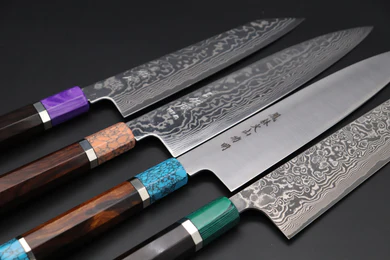Today let’s explore the artistry and precision of Japanese knives. From the iconic Santoku to the elegant Yanagiba, each blade tells a tale of centuries-old craftsmanship. Jump into the diverse world of Japanese knives, where form effortlessness meets function in the realm of culinary excellence. We at Best Knife For You have curated a list of all the types of Japanese Knives. Let us start with the basics.
What is a Japanese knife?
A Japanese knife is a culinary masterpiece, carefully crafted with precision and age-old techniques. Out of the many types of knives they are renowned for superior sharpness and cutting efficiency, these knives are a testament to centuries of Japanese craftsmanship.
A Japanese knife has an average blade length of 6 to 9 inches and a width typically between 1.5 to 2 inches. These knives vary in design, as each of them are tailored for specific culinary tasks.
The price range is vast, from affordable options starting around $50 to high-end knives exceeding $500, reflecting the diverse quality and craftsmanship available.
Japanese knives elevate the culinary experience, offering unbeaten performance and artistry in the kitchen.
All 15 Japanese Knives
Let us briefly explain each one of these splendid sharp tools which people are dying to get their hands on.
1. Bunka- Fusion Knife

The Bunka knife, a versatile fusion of chef’s and vegetable knives, boasts a pointed tip for intricate tasks. Perfect for slicing and dicing, Bunka knives have a length of 4 to 7 inches and a width of 1.5 to 2.5.
These knives are crafted from high-carbon stainless steel, ensuring long-lasting sharpness.
2. Gyutou-Chef’s Knife
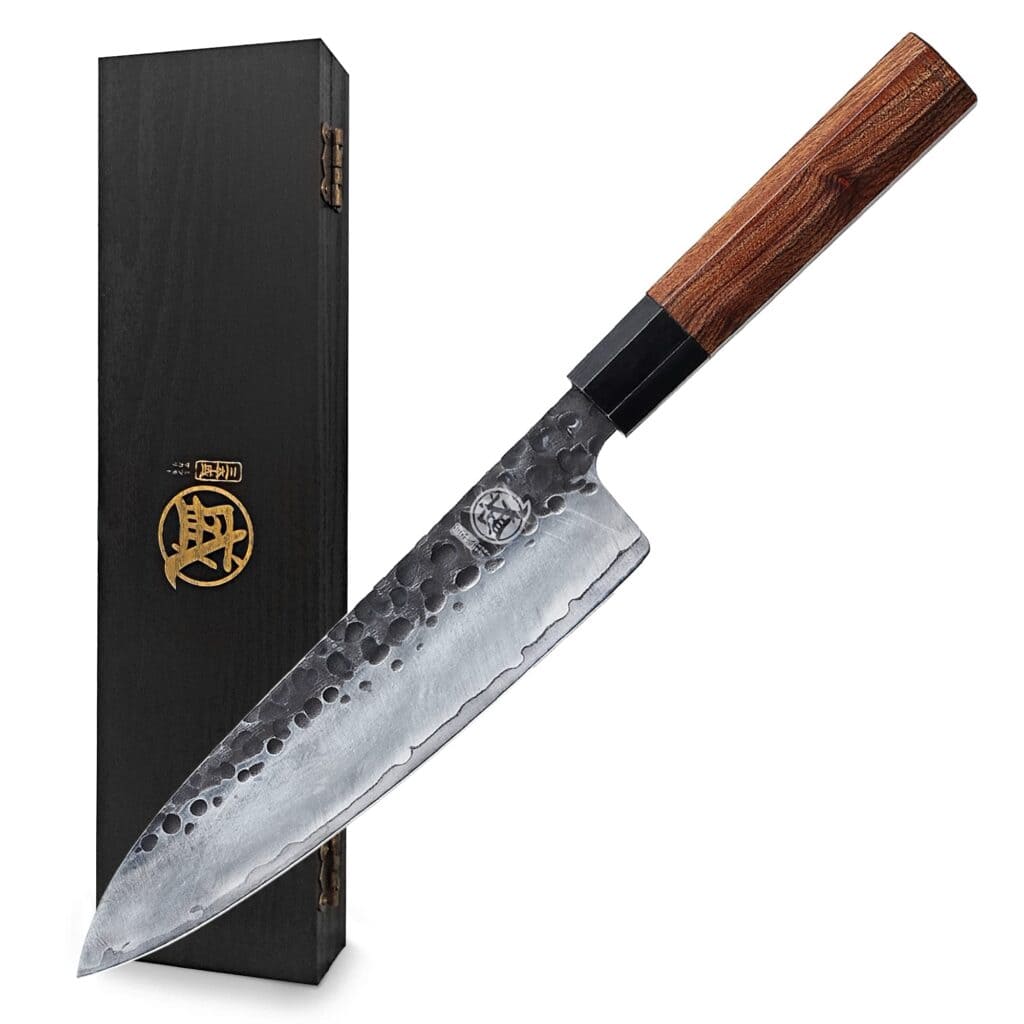
The Gyutou, a traditional Japanese knife, is a beautiful tool to work with. Most of these knives have a damascus pattern for efficient slicing and chopping.
A Gyutou has an average length of 8 to 12 inches and width of 1.5 to 2 inches. A Japanese Gyutou knife is made from high-carbon steel, guaranteeing exceptional sharpness and durability.
3. Santoku- Multipurpose Knife
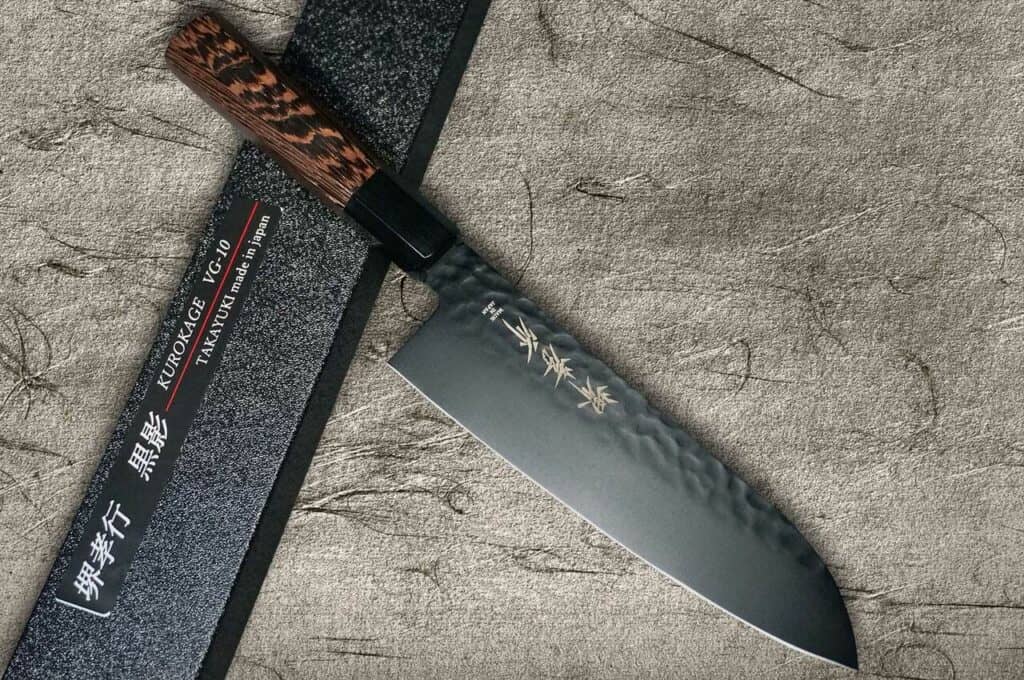
Celebrated for its all-purpose functionality, the Santoku knife excels in slicing, dicing, and chopping. These knives have a broader blade and shorter length of 6 to 7 inches, Santoku knives offer precision and efficiency.
This Japanese knife is crafted from high-carbon stainless steel, ensuring top-notch performance in the kitchen.
4. Sujihiki- Slicer Knife

The Sujihiki knife specializes in precise slicing/cleaning of meats and fish. This knife is longer than other Japanese knives, with length ranging from 9 to 12 inches with a slender 1.5-inch width.
A Sujihiki knife delivers thin, precise cuts effortlessly. Constructed from high-carbon stainless steel, this type of Japanese knife guarantees sharpness for delicate slicing tasks.
5. Petty- Paring Knife

The Petty knife comes under the paring knife category. It is excellent for small tasks like peeling and trimming. With a length of 4 to 7 inches and a width of approximately 1 inch, Petty knives are quite handy for beginners.
A Petty knife is crafted from high-carbon steel, as this ensures durability and sharpness for precise cutting needs.
6. Honesuki- Boning Knife

The Honesuki knife, a specialized Japanese boning knife, has been designed for cutting poultry and meat, especially de-boning them. With its pointed tip and triangular blade, it moves around joints and bones with precision, minimizing any wastage of meat.
The length of the Honesuki blade is around 5.5 to 7 inches. Its blade is similar to a right angled triangle and the widest part is around 1.6 to 2 inches in width.
A Honesuki is created from a carbon steel core with a layer of stainless steel. The knife guarantees sharpness and durability, making it an essential tool for chefs and butchers.
7. Hankotsu- Boning Knife

Another boning knife in the list of Japanese knives is the Hankotsu knife. It stands as a robust Japanese de-boning specialist, known for its ability to break down large cuts of meat.
It has a long, measuring around 5.5 to 6.5 inches with a width of around 1.5 inches. This sleek design provides the strength needed for heavy-duty boning tasks.
The pointed tip guarantees proper insertion and the blade moves in a precise manner around joints and bones. Making the whole boning process of meat quite easy.
Crafted from hardened stainless steel, the Hankotsu knife combines durability and sharpness, making it a reliable companion in the demanding world of butchery.
8. Nakiri- Vegetable Knife

The Nakiri, meaning “vegetable cutter” in Japanese, is one of the best vegetable cutting knives. Its defining feature is a thin, rectangular blade with a straight cutting edge and a blunt, squared-off tip.
Unlike a traditional chef’s knife, it does not have a pointed end, making it ideal for push-cutting vegetables with a straight up-and-down motion. A technique which is quite famous in Japan.
This full-blade contact ensures clean, even cuts through everything from delicate herbs to hard vegetables. It measures around 6.5 to 7 inches in length.
With its focus on precision and power chopping, the Nakiri becomes an extension of your hand, transforming vegetable prep into a satisfying task.
9. Yo-deba- Butcher Knife

The Yo-deba knife, a Japanese butchery tool, looks similar to a chef knife. It has a robust and thick blade designed for a variety of butchering tasks. With a length of around 7 to 9 inches and a sturdy blade width, it provides the strength and stability needed for breaking down meat cuts.
Crafted from high-carbon stainless steel, the Yo-deba knife guarantees durability and sharpness. All these factors make the Yo-deba an essential addition to your knife collection.
10. Yanagi- Sushi Knife

You may have seen videos of a Itamae (sushi chef) using a long knife to cut through sushi, well the knife that is used by the chef is a Yanagi.
The Yanagi knife, also known as the Sushi Slicer, is a Japanese blade designed for the delicate art of slicing fish for sushi and sashimi. It features a long and sleek blade measuring around 9 to 12 inches, with a width of around 2-2.5 inches.
This incorporates a single bevel for precise slicing. It is made from high-carbon stainless steel, so that it doesn’t dull down fast.
11. Takobiki-Slicer Knife

Resembling a small sword, the Takobiki knife is a distinguished Japanese slicer knife. It is used for the precise art of slicing sashimi and delicate cuts of fish.
Its elongated, thin blade, measuring around 10 to 12 inches, ensures exceptionally clean and smooth slices, enhancing the presentation of Japanese dishes. The Takobiki is longer than the Yanagi.
The narrow blade width is modeled for precision, making the Takobiki an indispensable tool for chefs who demand perfection.
Takobiki is made out of stainless steel, ceramic or Aoko (blue steel). This knife not only guarantees the sharpness required for exquisite slicing but also ensures long-lasting durability.
12. Deba-Butcher Knife
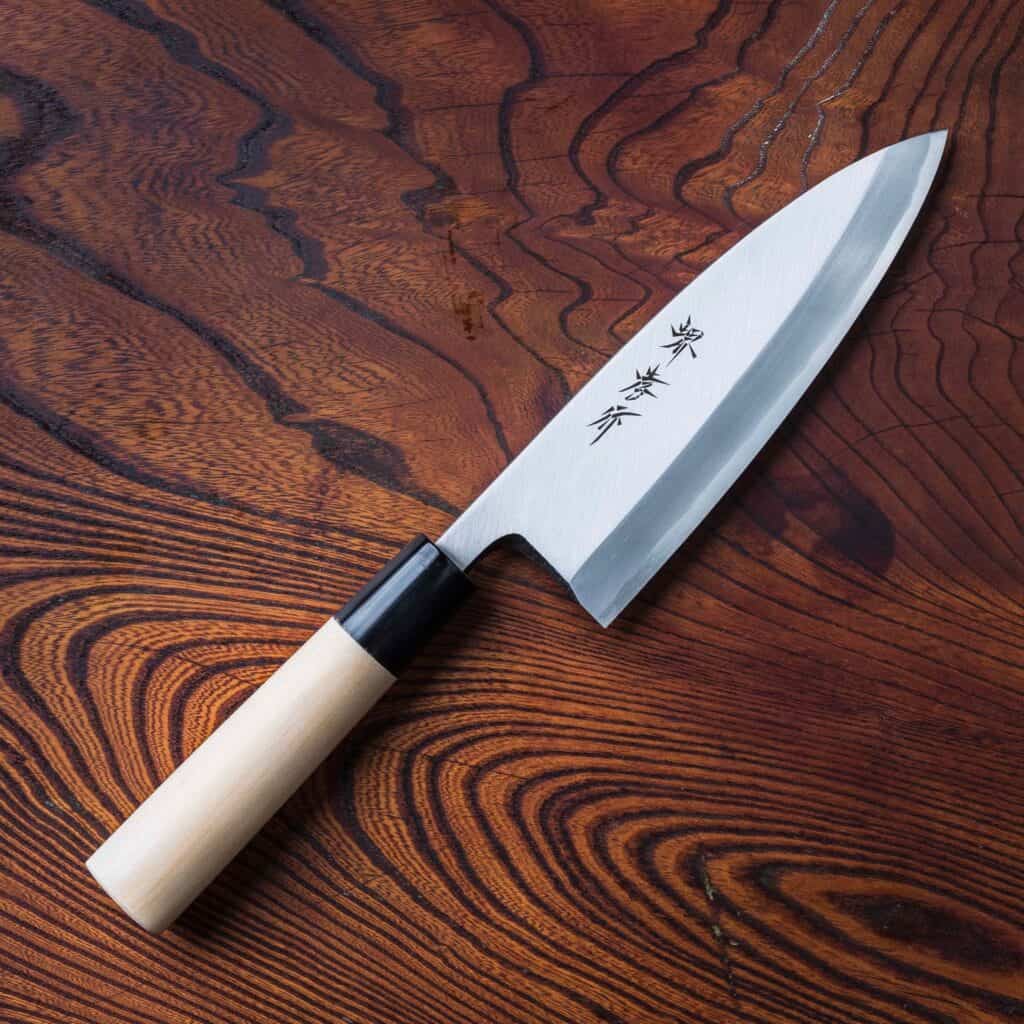
The Deba knife stands as an essential Japanese butchery tool. It is characterized by its strong and thick blade, making it well-suited for a variety of butchering tasks.
With a length of around 6 to 8 inches and a 2-2.5 inch width, the Deba knife provides the strength and stability required for breaking down meat cuts with precision.
Traditional Deba knives are made out of high-carbon steel, but modern Deba knives are also made out of stainless steel.
This knife ensures both longevity and sharpness, reflecting the greatness of the artistry of traditional Japanese knives.
13. Usuba-Vegetable Knife

The Usuba knife, a chonky Japanese vegetable knife, is a straight-edged, rectangular blade tailored for chopping vegetables with a push-down motion.
It has a length of around 5 to 7 inches and a broader blade width. The Usuba facilitates efficient vegetable preparation, making it a go-to knife for chefs seeking accuracy and efficiency in the art of cutting vegetables.
Crafted from Japanese stainless steel and Japanese white steel (Shirogami), this blade is rust-free and durable. It retains its sharpness if taken care of properly.
14. Kiritsuke- Slicer Knife

The Kiritsuke knife is a sturdy Japanese slicer which seamlessly blends features of both a Yanagi and Usuba knife.
It has a length of around 8 to 10 inches and a moderate blade width of 1.5 inches. Kiritsuke can be used for slicing, dicing and chopping.
This Japanese knife is made out of white or blue steel. It offers the versatility and sharpness demanded by chefs who appreciate a multifunctional blade, whilst staying true to the values of traditional Japanese culinary craftsmanship.
15. Pankiri- Bread Knife
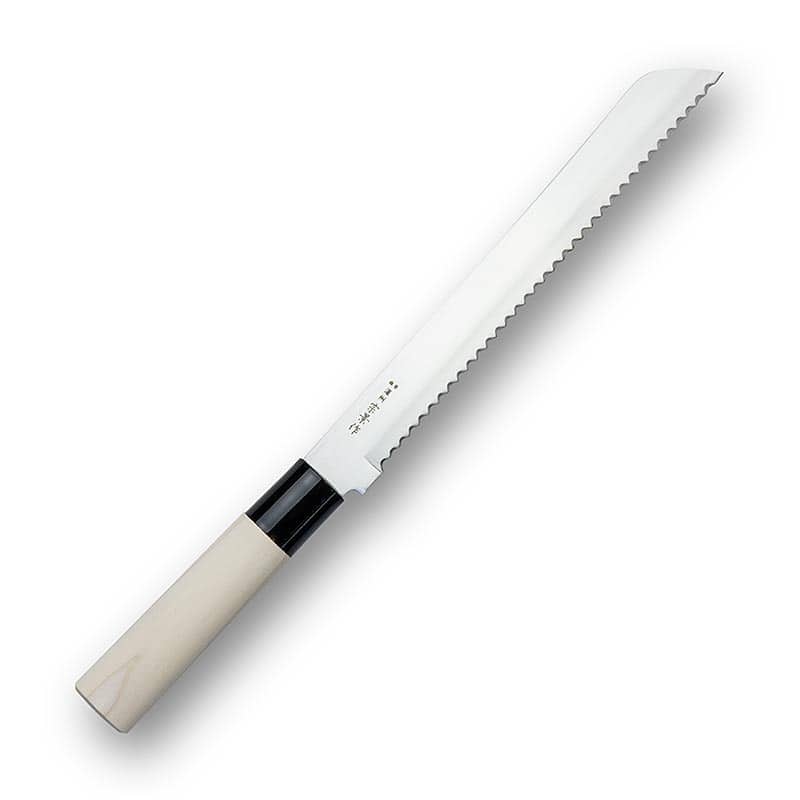
The Pankiri knife is a Japanese bread knife, ingeniously designed for the effortless slicing of bread and other baked goods.
It has a length of around 8 to 9 inches and a serrated blade, it ensures clean, precise cuts without compromising the texture or ruining delicate baked items.
The Pankiri is made out of hard central core steel and is layered with stainless steel for strength. It not only promises durability but also the sharpness required for perfect bread slicing. This is one of the best types of Japanese knives that you can add to your kitchen.
These Japanese knives, with their unique designs and specific functionalities, display the rich diversity and accuracy of traditional Japanese craftsmanship. All these Japanese knives are crafted from high-quality steel, each knife in this list promises durability and sharpness.
What are Japanese knives made out of?
Japanese knives are renowned for their exceptional craftsmanship. The materials which are used to make them play a vital role in their greatness.
The blades of these knives are commonly crafted from high-carbon stainless steel, white steel, Aoko- blue steel or even other alloys.
All this to make sure that the knife strikes a delicate balance between sharpness and durability. These materials allow for a razor-sharp edge, crucial for precision cuts in Japanese culinary techniques.
The addition of carbon enhances hardness, ensuring that the blade retains its sharpness through extensive use. The stainless steel component contributes to corrosion resistance, making the knives easier to keep over the years.
Another notable material employed in crafting a Japanese knife is Damascus steel. Renowned for its distinctive, beautifully patterned surface, Damascus steel is often composed of multiple layers of high-carbon and low-carbon steel.
The layering adds to the visual appeal while also enhancing the blade’s strength and resilience. The intricate patterns, created through the layering process, are a testament to the artisanal skill involved in forging these knives.
In addition to the blade, the handle of the types of Japanese knives is a crucial component. Handles are crafted from various materials, including wood, synthetic composites, or even animal horns.
Wooden handles, such as those made from magnolia or ho wood, provide a comfortable grip and are often preferred for their natural aesthetic.
Synthetic handles, made from materials like Micarta or Pakkawood, offer durability and resistance to water damage. The choice of handle material complements the overall balance and feel of the knife, ensuring that it aligns seamlessly with the user’s preferences and the specific demands of Japanese culinary traditions.
In essence, the materials chosen for Japanese knives reflect a harmonious blend of tradition, functionality, and artistry.
Why are Japanese knives so popular?
Japanese knives have gained popularity in the past decade due to their several distinctive qualities, deeply ingrained craftsmanship and design of these culinary tools.
The most valuable among these characteristics is the exceptional sharpness of every type of Japanese knives. With a diverse range of knives tailored for specific culinary tasks, such as the all-purpose Santoku or the delicate Yanagi for slicing sashimi, the Japanese collection of knives have one tool for every cooking style.
This specialization allows chefs to be skillful in different stages of food preparation, making Japanese knives a staple in both professional and home kitchens.
Ending Remarks on Japanese Knives
In the world of culinary brilliance, the various types of Japanese knives stand as more than tools—they are a fusion of precision, artistry, and tradition. From their razor-sharp edges to their detailed craftsmanship, each knife reflects a cultural legacy. Embrace the essence of Japanese culinary mastery with these knives, where efficiency becomes a form of art.

